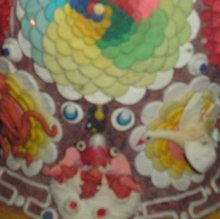Case Study 8: Gandandarjaaling Monastery
 |
 |
 |
Photo courtesy of the Tributary Fund. |
The following information has been extracted from the
Mongolian Buddhists Protecting Nature Handbook which can be downloaded in English and in Mongolian.
Gandandarjaaling Monastery is a small monastery located in the remote Khan
Khokhii region of Mongolia. First established in 1818, it was restored in 1990. The
monastery currently has 17 lamas.
The monastery has received a grant from ARC to test the water quality at sacred
springs in the area. Local sacred sites include: Khan Khokhiin ovoo, Tsagaan Nuuryn
ovoo, Khosyn ovoo, Takhiltyn ovoo, Delger ovoo, Modtolgoin ovoo, Gichgiin gol,
and Khangiltsagiin gol.
Under the WWF/ARC Khan Khokhii Conservation project, activities have also been
carried out in the region to help reduce logging and create alternative energy
sources. The project provides ecological training targeted at the Buddhist monastic
and lay community in support of the struggling monasteries in this remote region.
Contacts
Tel: +976-014541260
Pages about Mongolian Environmental Wisdom, taken from the Handbook.
The Mongolian Lord of Nature.
Sacred texts, places and ovoos.
Sacred sites
in Mongolia.
Traditional Environmental Law in Mongolia.
The work that the monks, in conjunction with ARC and the World Bank and others, are carrying out to rediscover the sutras about sacred land in Mongolia.
Do you want to support this?
For full contact and address details of Mongolian Buddhist Monasteries, please see page 57 of the
Handbook. And for details of local Development, Environmental and Educational NGOs, please visit pages 58-59 of the
Handbook.
Other links to Mongolian Buddhism and the Environment
Link here to access the news story about the launch of the Mongolian Buddhist Handbook.
Link
here to download the Mongolian Buddhist Handbook in English. (Please note this file is 1.15MB)
Link
here to download the Mongolian version of the Handbook.(A 2MB file.)
Link here to download the guide to the Mongolian Buddhists’ Eight Year Plan (this file is 4.13MB).
Link to Mongolian Case Studies.
And
here on how to make contact with the Sangha.
To download the A3 poster of a new thangka about Buddhists protecting Nature, link
here (5.61MB).
Brief History of Mongolian Buddhism.
Buddhism and the Environment.
Women in Buddhism in Mongolia.
Key Figures in Mongolian Buddhism.
Key Meetings in Mongolia.
Mongolian Buddhists and Development.
Mongolian Buddhists and Ecology.
Mongolian Buddhist Hunting Ban.
The Lost Sutras.
|

